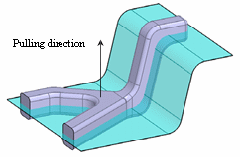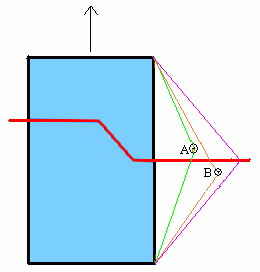This capability is applicable when the ribbon propagation
encounters the first twist in the draft skin while creating a draft for
a single body.
It will reduce some steps and design time.
With this capability, drafts will not fail in case of twist, but instead
drafts the maximum ribbon and leaves undrafted the twisted zones.
The twist problem basically arises because of the following reasons:
-
When reflect/neutral curve tends to become parallel
to the pulling direction.
-
When there is a collision between non-adjacent draft
faces. This happens when reflect/neutral curve is not a straight line
and we have relatively large draft angle.
Consider a solid part to be drafted. The input data such
as pulling direction, parting surface, draft angle value are specified.

Starting from the selection (leftmost figure below), the maximum draft
creates the longest draft ribbon on the solid, until a twisted surface stops
the draft progression (rightmost figure below). Now the draft operation
does not fail because of twist.


To draft the whole body, the procedure can be repeated
by creating another maximum draft, selecting
new faces (left figure below). Once more, some twisted
surface can interrupt the draft ribbon (right figure below).


The cap faces are created at the location where draft ribbon propagation
stops because of twist. Finally you can fill this portion and joins those
with the draft result to get final result.

-
The maximum both sides draft capability is applicable
only with the Draft Both Sides function with Fitted
option and Advanced Draft function.
-
If you selects faces to draft such that, they are
separated by a twist, then the draft operation will fail with a Multi-Ribbon
error. This is because, draft ribbon propagation in a direction stops
as soon as first twist is encountered. A new ribbon is required to cover
the remaining faces to draft (if any) which were selected by you. The
multiple ribbons are not yet supported in Draft Both Sides
with Fitted option.






